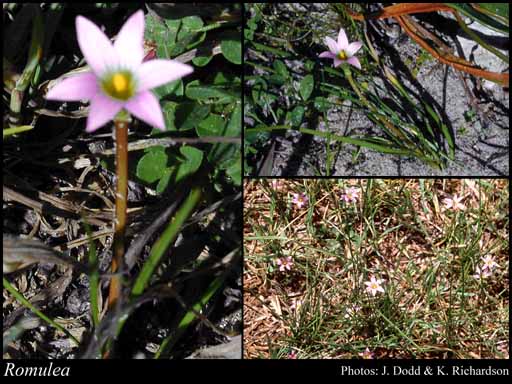- Reference
- Pl.Romul.Saturn. p13 (1772)
- Name Status
- Current







Scientific Description
Common name. Onion-grasses. Family Iridaceae.
Habit and leaf form. Herbs (small); evergreen, or deciduous. Perennial (annual leaves and flowers). Leaves basal, or basal and cauline (rarely). Plants with a basal concentration of leaves, or with neither basal nor terminal concentrations of leaves; cormous (globose to bell-shaped or ovoid; tunic hard and smooth). Helophytic to xerophytic. Leaves alternate; distichous; ‘herbaceous’, or leathery; sessile; sheathing. Leaf sheaths with free margins. Leaves foetid, or without marked odour; edgewise to the stem, or with ‘normal’ orientation; simple; epulvinate. Leaf blades entire; flat, or solid; terete (or compressed); linear, or lanceolate; linear (to ensiform principally or filiform); parallel-veined; without cross-venules; open or closed sheaths. Leaves eligulate; without stipules. Leaf blade margins entire. Leaves with a persistent basal meristem, and basipetal development. Leaf anatomy. Hairs absent. Extra-floral nectaries absent. Stem anatomy. Secondary thickening absent.
Reproductive type, pollination. Fertile flowers hermaphrodite. Unisexual flowers absent. Plants hermaphrodite. Floral nectaries present, or absent. Nectar secretion from the perianth (from nectaries at the tepal bases). Entomophilous, or ornithophilous, or anemophilous.
Inflorescence and flower features. Flowers solitary, or aggregated in ‘inflorescences’; in panicles, in cymes, in spikes, in umbels, and in corymbs. The terminal inflorescence unit cymose, or racemose. Inflorescences terminal; scape 1-several, shorter than the leaves; peduncle semiterete, often recurving after flowering; spatheate. Flowers sessile; bracteate (2 per flower, inserted at the base of the ovary and enclosing it, spathe-like, entire, acute, herbaceous; inner bract often scarious or with hyaline margins); ebracteolate; small to large; regular; 3 merous; cyclic; tetracyclic. Perigone tube present. Free hypanthium short. Perianth of ‘tepals’; 6; 2 -whorled; isomerous; petaloid; without spots, or spotted; similar in the two whorls, or different in the two whorls; white, or yellow, or orange (orange-brown), or pink. Androecial members definite in number. Androecium 3. Androecial members adnate; all equal; free of one another (usually), or coherent; when united, 1 - adelphous; 1 -whorled (representing the outer whorl). Androecium exclusively of fertile stamens. Stamens 3; all more or less similar in shape; reduced in number relative to the adjacent perianth to isomerous with the perianth; on the perianth tube opposite the outer segments; alterniperianthial (opposite the outer perianth lobes). Anthers basifixed; dehiscing via longitudinal slits; extrorse. Gynoecium 3 carpelled. The pistil 3 celled. Gynoecium partly petaloid, or non-petaloid; syncarpous; synstylovarious; inferior. Ovary plurilocular; 3 locular. The ‘odd’ carpel anterior. Gynoecium stylate. Styles 1; apical. Stigmas 6 (or 3). Placentation axile. Ovules 20–50 per locule (many); arillate, or non-arillate; anatropous.
Fruit and seed features. Fruit non-fleshy; dehiscent; a capsule. Capsules loculicidal (from the apex). Fruit 3 celled; 20–100 seeded (many). Seeds endospermic. Endosperm oily. Cotyledons 1 (coleoptile-like). Embryo straight (small). Testa without phytomelan.
Etymology. From the Latin Romulus, descended from Romulus, the first king of Rome; generally a Roman; several species grow around Rome.
Taxonomic Literature
- Wheeler, Judy; Marchant, Neville; Lewington, Margaret; Graham, Lorraine 2002. Flora of the south west, Bunbury, Augusta, Denmark. Volume 1, introduction, keys, ferns to monocotyledons. Australian Biological Resources Study.. Canberra..
- Australia. Bureau of Flora and Fauna 1986. Flora of Australia. Volume 46, Iridaceae to Dioscoreaceae. Australian Govt. Pub. Service.. Canberra..